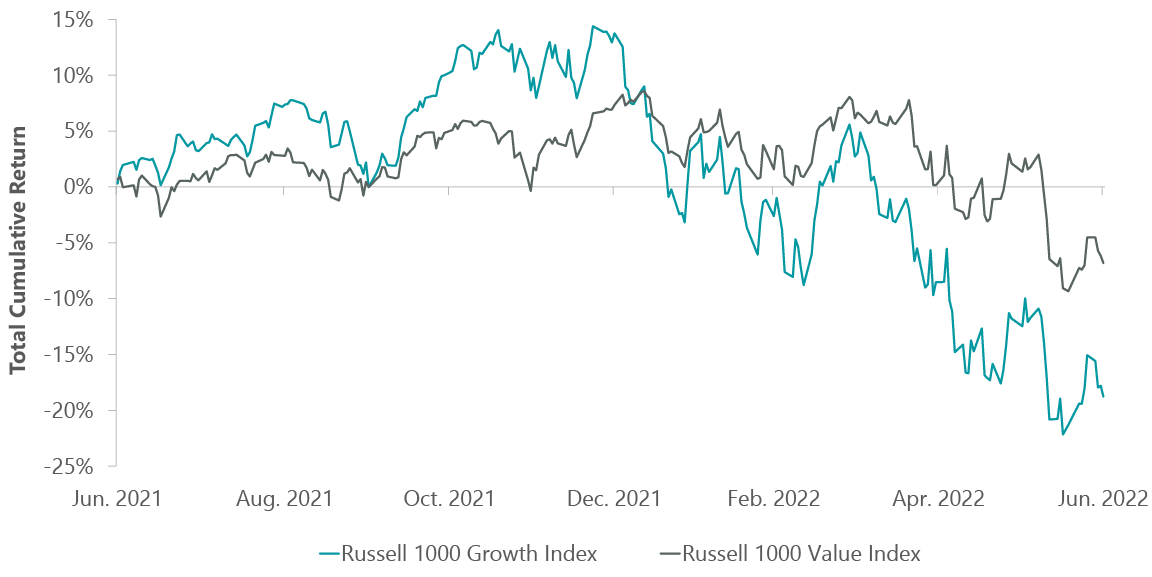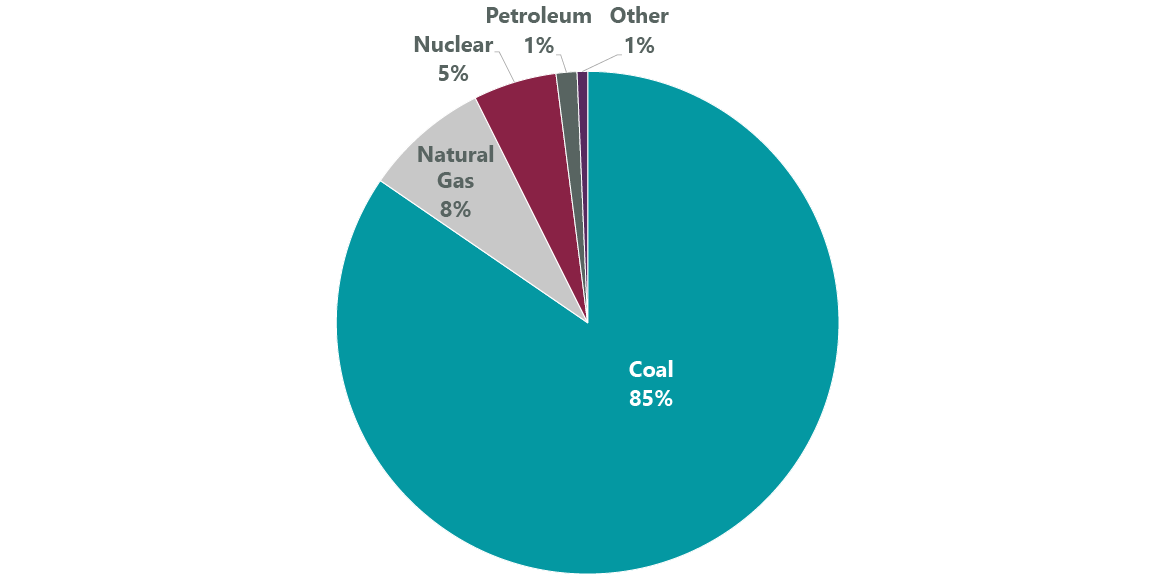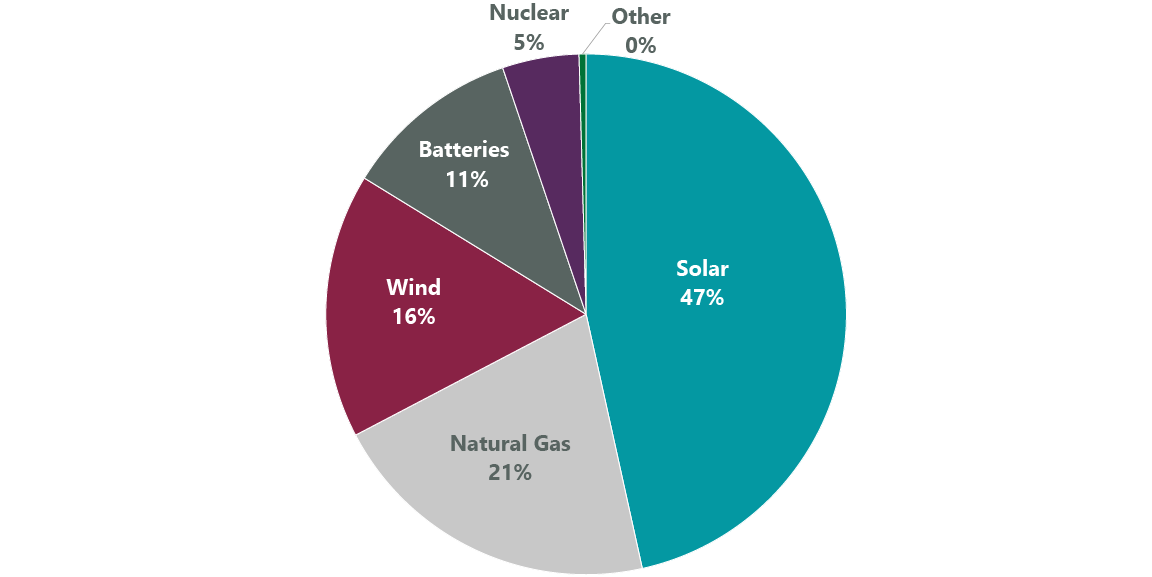Khanchit Khirisutchalual
Climate Insights Provide Pathway to Future Growth
Market Overview
Worsening inflation and aggressive actions from the Federal Reserve to contain it sent equity markets spiraling in the second quarter. Investor optimism retreated in the face of persistent price pressures, global supply chain disruptions and rising recession risks, pushing the S&P 500 Index down 16.10% for the quarter, capping its worst start to the year (-19.96%) since 1970. Rising interest rates continued to weigh most heavily on growth stocks with the benchmark Russell 1000 Growth Index falling 20.92% for the quarter, underperforming the Russell 1000 Value Index by 871 basis points. Growth trails value by over 1,500 bps year-to-date.
Exhibit 1: Growth/Value Gap Continues to Widen

As of June 30, 2022. Source: FactSet.
Disruptions in global supply chains stemming from COVID-19 lockdowns in China, the Russian invasion of Ukraine and commodity shortages continued to propel inflation higher. A worse than expected 8.6% Consumer Price Index reading for May caused the Fed to raise rates 75 bps in June, the most aggressive hike since 1994, and project ambitious tightening through the rest of 2022. The 10-year Treasury yield climbed 67 bps to finish the quarter at 3.01%, near its highest level in four years.
The U.S. economy contracted in the first quarter and the outlook for GDP growth has tempered as more liquidity leaves the financial system. While consumer demand has mostly held up, a shift in spending patterns from goods to services led to big first-quarter earnings misses and lowered outlooks for several retailers and social media platforms that are leading digital advertisers. We are, no doubt, in the type of low-growth environment where the ClearBridge Large Cap Growth ESG Strategy should thrive. We manage the Strategy in a diversified, valuation-sensitive manner to participate in up markets but also provide a degree of protection during volatile periods.
In the second quarter, however, the uncertainties unique to COVID-19 and the subsequent peak everything environment acted as headwinds to performance. The Strategy underperformed the benchmark, with weakness centered among several key COVID-19 beneficiaries that are seeing tough comparisons, rising input costs or both. The pandemic added a layer of complexity to managing businesses with companies challenged in discerning real trends in their operations from one-time COVID benefits.
Amazon.com (AMZN) was a primary detractor due to a disappointing outlook for profitability in its retail business. Following a surge of e-commerce demand in 2020 and 2021, the company has now overbuilt fulfillment infrastructure as e-commerce demand has moderated. While we believe current profitability levels are suboptimal, Amazon.com is working rapidly to rectify overcapacity issues and we believe the retail business has a robust long-term profitability outlook. We also believe Amazon is well-positioned to emerge stronger from this difficult operating environment of higher costs. There is a visible path to margin expansion driven by a positive mix shift as the more profitable businesses of third-party sellers, cloud, and advertising become the largest contributors.
Chipmaker Nvidia (NVDA) has also been pressured by multiple compression of higher growth companies and weakness in its gaming business. While Nvidia has grown into a top 10 position with its strong performance through late 2021, we have been consistently trimming the position to derisk against short-term volatility in its gaming business. The company is clearly exposed to the semiconductor cycle but also participates in the secular growth of cloud and AI adoption through its data center business. With these secular drivers intact and new products ramping up in the second half of the year, we are maintaining an overweight to the company.
Multiple compression has also hurt higher growth health care companies like DexCom (DXCM), despite its strong fundamentals. We continue to build out the position as we gain greater visibility on the catalysts of accelerating uptake in Type 2 diabetes patients and the launch of its G7 continuous glucose monitor in the U.S. and Europe. DexCom was hurt in the quarter by market speculation that it would acquire a diabetes pump provider, which would be outside of its core competency.
Portfolio Positioning
After seeding the portfolio with select growth companies in the second half of 2020 and 2021, we have redirected our focus over the last several quarters to risk management. Moves during the second quarter in pursuit of greater stability included reducing consumer discretionary exposure with the sale of omnichannel cosmetics retailer Ulta Beauty (ULTA).
We exited Ulta as our thesis has largely played out in terms of a post-COVID 19 earnings recovery. Ulta has steadily gained share over the last several years and its partnership with Target (TGT) represents a new avenue to gain customer loyalty. That being said, we are wary about the resilience of the consumer and the impact of labor cost inflation, which could crimp Ulta’s margin expansion in coming quarters. As with recent activity, the sale further reduces our consumer discretionary exposure and helps manage portfolio risk through an ongoing period of volatility.
“Digital transformation enabled by software companies is clearly secular but we could see a short-term softening as cyclical factors are considered.”
Within information technology (IT), where we maintain an underweight compared to the benchmark, we took profits in NXP Semiconductors (NXPI), a part of the pro-cyclical reflation basket built up in 2020. Despite strong current fundamentals, there is an ongoing risk of major supply increases in the semiconductor industry as capacity announcements are near records.
Rounding out our risk-focused stance, we believe the addition of Sherwin-Williams (SHW), a manufacturer of paints and coatings for professional, industrial and retail customers, adds further resilience in the current inflationary environment. Paint is a relatively small part of total project input costs which can be passed through with price during inflation, and the company has a track record of successfully managing through periods of increased commodity costs. We are attracted to the company’s durability of growth by operating a strong franchise with both organic growth and consolidation amassing a strong portfolio of brands. We like Sherwin-Williams over competitors in the paint industry due to higher volumes, a domestically focused revenue base and strong relationships with the home builder and pro community. We believe the company will be able to keep pricing and expand margins as commodity pressures ease.
Outlook
The aggregate result of these transactions is a more concentrated portfolio with higher active share that best represents our highest conviction names. We constantly analyze our positions to determine which to hold and which to add to on weakness. Most of our recent additions have been in areas where we see the greatest earnings visibility and valuation support, while we have been staying put or cutting back on holdings in the most expensive areas of technology and the Internet. That said, we maintain a watch list of companies and some dry powder to respond to dynamic market conditions. Further clarity on the extent of Fed tightening and the slope of the yield curve will give us greater confidence to be buyers of select growth companies.
The downdraft this year in technology has been predominantly driven by multiple contraction, rather than earnings. We are hearing from our software companies about deal push outs and negative FX impacts but have yet to see downward revisions. Such data points are concerning because it means these companies now have less cushion to cover any negative surprises. We will be parsing second quarter results closely to help determine if demand destruction is starting to occur and if our estimates of earnings growth are still valid. The decade-long trend of digital transformation enabled by software and related technology companies is clearly secular but we could see a short-term softening as cyclical factors are considered.
The Strategy has historically generated solid relative results during market corrections and, despite recent performance struggles, we are committed to the formula that has compounded growth for our investors: a focus on stock selection for the long term. We remain dedicated to conducting robust fundamental analysis that leads us to attractive growth opportunities and managing a portfolio with a diversified set of drivers over a 3-to-5-year time horizon. We believe that a duration of growth mindset is a key differentiator that should play out as normalization of the market and economy continue.
Portfolio Highlights
The ClearBridge Large Cap Growth ESG Strategy underperformed its benchmark during the second quarter. On an absolute basis, the Strategy posted losses across eight of the nine sectors in which it was invested (out of 11 sectors total). The lone contributor was the consumer staples sector while the primary detractors from performance were in the IT, consumer discretionary and communication services sectors.
Relative to the benchmark, overall stock selection detracted from performance but was partially offset by positive sector allocation effects. In particular, stock selection in the IT, communication services and health care sectors and an underweight to consumer staples hurt results. On the positive side, an overweight to health care as well as stock selection in the consumer staples sector contributed to performance.
On an individual stock basis, the leading absolute contributors were positions in Monster Beverage (MNST) and UnitedHealth Group (UNH). The primary detractors were Amazon.com, Nvidia, Meta Platforms (META), Microsoft (MSFT) and Netflix (NFLX).
ESG Highlights
Analyst-Led Engagements Uncover Value
Environmental, social and governance (ESG) investing has made much progress over the last two decades. Investors in public equities and corporations have taken more ownership of the impact they can have mitigating climate change and making progress on social goals such as diversity, equity and inclusion; ESG data and investment products have proliferated; and ESG assets under management have continued to grow, with most continuing to be actively managed.
Amid such growth has come scrutiny over potential differences between the claims and realities of ESG investing. This has come on the part of regulators, asset owners and increasingly in the public eye, among business and government leaders.
In this environment we think it worthwhile to highlight the value added by ClearBridge engagements and their role in our investment process and stewardship activities. We have made steady improvements and progress in our process, marked by several milestone years, from 2005, when we established a central research platform that began integrating ESG factors by sectors, to 2012, when we explicitly incorporated ESG analysis in analyst compensation and performance reviews, to 2014 when we formally introduced proprietary ESG ratings, which capture company-specific drivers of risk and return related to sustainability. Currently, 100% of our actively owned companies have an ESG rating assigned.
A key through-line in our history of ESG integration, and a key point of differentiation, is that it is carried out by our analysts: we think there is immense value in having the same person responsible for covering a company’s fundamentals and its ESG characteristics. Company engagements, therefore, are likewise led by ClearBridge sector and portfolio analysts, an approach that we believe gives them insights that might not be top of mind for other investors and a fundamental edge, gained through long-term discussions with CEOs and CFOs of portfolio holdings.
Transforming Climate Risks to Opportunities
In many cases, ClearBridge engagements have specific objectives, such as encouraging the retirement of fossil fuels and increasing use of renewables. Such has been the case with electric power company AES (AES), with whose executives and board members we have been engaging for several years on the company’s path to reduce its carbon footprint. We believe our voice, as a top shareholder, has been a valuable addition to AES’s decision making along this path, and our engagements have helped us identify where climate-related risks in a company’s operations could be climate-related opportunities.
Several years ago, we began discussing with AES the lack of terminal value from coal (Exhibit 2), and we expressed how coal-related ESG concerns were weighing on AES’s valuation multiple, as the ESG risk premium was rising. We helped convince AES to stop investing in coal plants and start shutting down existing coal capacity. The next step was to add renewable energy exposure in the form of wind, solar and industrial scale battery storage (Exhibit 3), in line with U.N. Sustainable Development Goal (SDG) 7: Affordable and Clean Energy (we discuss how an investment framework may further the SDGs in our 2022 Stewardship Report). We shared our belief that any lost near-term operating earnings would be made up with a higher valuation multiple.
Exhibit 2: Planned U.S. Utility-Scale Electric Generating Capacity Retirements 2022 (14.9 GW Total)

As of Jan. 11, 2022. Source: U.S. Energy Information Administration.
Exhibit 3: Planned U.S. Utility-Scale Electric Generating Capacity Additions 2022 (46.1 GW Total)

As of Jan. 11, 2022. Source: U.S. Energy Information Administration.
As our discussions have progressed, AES has been increasingly aggressive in reducing its carbon intensity by lowering coal capacity and investing in renewable energy, as evidenced by its declining GHG emissions. As we had anticipated, AES’s valuation multiple recovered as its product mix shifted from coal to renewables.
ClearBridge encourages companies to align their net-zero goals with the Science Based Targets Initiative’s (SBTi) standards, which clearly define pathways for companies to reduce carbon emissions in line with the Paris Agreement goals. In April 2022 we met with AES Investor Relations and its General Counsel to discuss setting science-based targets as the latest step in this path, and in line with SDG 13: Climate Action. At the meeting, AES confirmed it is exiting coal in 2025. The company continues to develop as a leader in renewable energy, in June 2022 announcing the formation with other leading U.S. solar companies of the U.S. Solar Buyer Consortium, which will invest more than $6 billion in solar panels to scale up domestic solar manufacturing.
Grasping Realities Behind Net-Zero Targets
Environmental impact is a major issue for the transportation industry, including logistics and freight companies such as portfolio holding United Parcel Service (UPS). Recent engagements with the company have given us a better understanding of the challenges in lowering emissions in transport as well as where innovations may be coming from in the years ahead. In ESG-focused engagements in March and May 2022, we discussed UPS’s path to net-zero using science-based targets.
Though it has a 2050 net-zero goal in line with SBTi, UPS has issues complying with SBTi standards because aviation constitutes 60% of UPS’s Scope 1 and 2 emissions. This is an area over which UPS has little control, however, and the maximum exclusion for a source of emissions for SBTi approval is 5%. UPS has committed to a 2050 carbon neutral goal, which is the same as the SBTi’s goal, although UPS takes a different view of the first 15 years of the path, finding existing technology unable to warrant as aggressive a path as SBTi’s.
Over the course of our engagements, we discussed the technical challenges facing the logistics and freight industry and the state of several key technological developments that will be crucial to helping the industry continue to lower emissions. For example, UPS is looking to sustainable aviation fuels, which are biofuels used to power aircraft with a smaller carbon footprint than jet fuel; however, planting to create the enormous amount of feedstock required to replace crude oil is not sustainable. Electric aircrafts are another potential solution, and UPS will have the first of 10 electric aircraft by Beta Technologies delivered by 2024, with an option for 1,400 more. While these planes help time-sensitive health care deliveries and benefit small and medium-size businesses, they have a range limited to 250 nautical miles. A more sustainable path, particularly for long-range transportation, could be the use of hydrogen, but the technology and infrastructure is in nascent stages of development and largely out of UPS’s control. We have encouraged the company, however, to increase pressure on its suppliers to accelerate the development of these technologies. ClearBridge also has ongoing active discussions with aerospace manufacturers on these issues.
Connecting Governance and Long-term Shareholder Value
In addition to finding value in engaging on climate risks, net-zero targets and new technologies, we also add value to our investment process with engagements on a variety of governance topics. For example, we have long supported toy and game maker Hasbro’s (HAS) management and board on strategic, operational and ESG-related topics; the company ranks highly on almost all areas of ESG evaluation, including diversity at board and all-employee levels. We maintain long-term relationships with Hasbro management, and in April 2022, after an activist shareholder started pushing for strategic change at the company, we stepped up our dialogue with senior management and the board.
While we appreciate some of the concerns raised by the activist, we were against most of its suggestions, which we believed would be destructive to long-term shareholder value. We did not believe it was in our best interest to replace three board members with activist-nominated board members — the existing board is replete with talent from the media, technology, content, gaming, entertainment and social media industries.
Over multiple meetings with Hasbro’s CEO and CFO and as many as three board members, our strong relationships helped us better understand what changes would be made where appropriate, and what strategies would remain intact. We had frequent opportunity to share our thoughts on board composition, long-term strategic priorities, compensation, capital allocation and disclosures. All of these became import topics for review during this time. In June 2022 the activist’s proposals were rejected by shareholders. We remain in support of management as it continues on its path of brand-building and growing digital content for its customers.
Advancing a Smart Farm Future
In our engagements with farm equipment maker Deere (DE), we have followed new technology as it has developed from early promise of environmental and social benefits to market reality. In March 2022, Deere’s Chairman & CEO and CFO met with ClearBridge’s investment team in our New York offices. While prior to the pandemic we had regularly hosted the company, this meeting was among the most interesting as the relatively new CEO outlined a bold plan that placed improved environmental stewardship squarely at the center of the company’s future.
Industrial farming, at its core, is not an especially environmentally friendly enterprise. Agronomic practices have improved over time, but fertilizer, herbicide and pesticide applications and water usage remain problematic. Deere believes its precision farming technology can drive down chemical and fertilizer volumes materially —possibly by as much as 70% — as sensors and cameras attached to tractors, sprayers and combines help determine the exact level of chemicals that might be required.
This more precise methodology is expected to:
- improve crop yields;
- reduce farmer input costs; and
- improve overall land management capabilities.
Farmers will make more money and grow more food to support global populations while at the same time better caring for the soil. There are also substantial environmentally positive knock-on effects because fertilizers largely are either carbon-based or mined.
There are also social benefits to Deere’s precision farming, such as increasing access to cost savings for smaller, non-commercial or family farms, and the contribution of improved crop yields toward SDG 2: Zero Hunger. This is in addition to its benefits for SDG 15: Life on Land through promoting sustainable use of terrestrial ecosystems. Deere’s technological strength also includes bringing connectivity to farmers in emerging markets, for example improving Wi-Fi access for farmers in Brazil.
New equipment pricing has moved much higher recently as Deere upgrades its offerings to support this effort. That said, the company has introduced substantial aftermarket packages so farmers using older equipment, who may not be able to afford completely new items, benefit from this technology.
Lastly, we discussed a timeline for transitioning large farm equipment away from diesel to an alternative fuel. At present, however, there is no viable alternative that has the power requirements necessary to drive a tractor for an hour, much less a full day, making any such transition a more distant opportunity.
Overall, we had been waiting to have this discussion for several years, and we were pleased the company’s technologies finally appear to have caught up to precision farming’s initial promise.
Editor’s Note: The summary bullets for this article were chosen by Seeking Alpha editors.


Be the first to comment